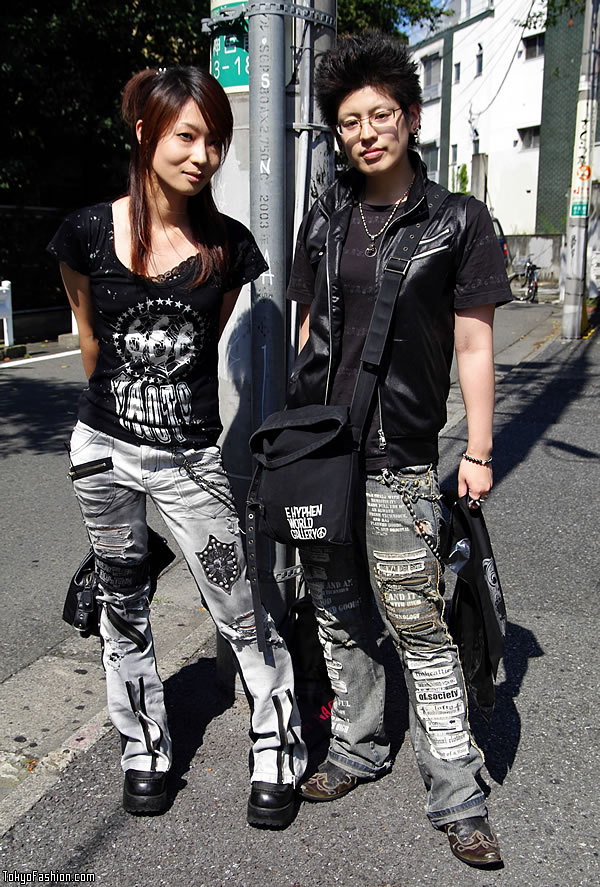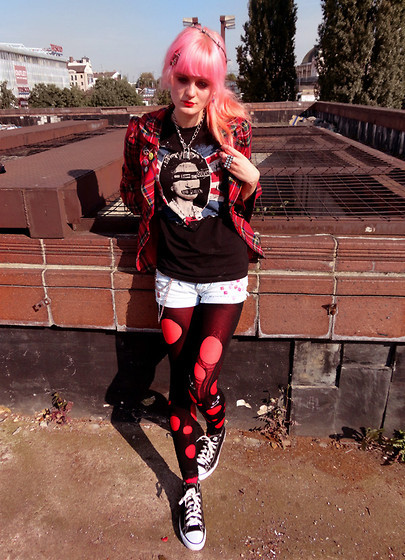Punk fashion has been extremely commercialized at various times, and many well-established fashion designers — such as Vivienne Westwood and Jean Paul Gaultier — have used punk elements in their production. Punk clothing, which was initially handmade, became mass produced and sold in record stores and some smaller specialty clothing stores by the 1980s. Many fashion magazines and other glamor-oriented media have featured classic punk hairstyles and punk-influenced clothing.
Punk rock was an intentional rebuttal of the perceived excess and pretension found in mainstream music (or even mainstream culture as a whole), and early punk artists' fashion was defiantly anti-materialistic. Generally unkempt, often short hairstyles replaced the long-hair hippie look and the usually elaborate 1970s rock/disco styles. In the United States, dirty, simple clothes - ranging from the T-shirt/jeans/leather jacket Ramones look to the low-class, second-hand "dress" clothes of acts like Television or Patti Smith - were preferred over the expensive or colorful clothing popular in the disco scene.
In the United Kingdom, a great deal of punk fashion from the 1970s was based on the designs of Vivienne Westwood and Malcolm McLaren and the Bromley Contingent. Mainstream punk style was influenced by clothes sold in Malcolm McLaren's shop.[1] McLaren has credited this style to his first impressions of Richard Hell, while McLaren was in New York City working with New York Dolls. Deliberately offensive T-shirts were popular in the early punk scene, such as the DESTROY T-shirt sold at SEX, which featured an inverted crucifix and a Nazi Swastika. These T-shirts, like other punk clothing items, were often torn on purpose. Other items in early British punk fashion included: leather jackets; customised blazers; and dress shirts randomly covered in slogans (such as "Only Anarchists are pretty"), blood, patches and controversial images.
Other accoutrements worn by some punks included: BDSM fashions; fishnet stockings (sometimes ripped); spike bands and other studded or spiked jewelry; safety pins (in clothes and as body piercings); silver bracelets and heavy eyeliner worn by both men and women. Many female punks rebelled against the stereotypical image of a woman by combining clothes that were delicate or pretty with clothes that were considered masculine, such as combining a Ballet tutu with big, clunky boots.
Punk clothing sometimes incorporated everyday objects for aesthetic effect. Purposely ripped clothes were held together by safety pins or wrapped with tape; black bin liners (garbage bags) became dresses, shirts and skirts. Other items added to clothing or as jewellery included razor blades and chains. Leather, rubber and vinyl clothing have been common, possibly due to their connection with transgressive sexual practices, such as bondage and S&M.
Preferred footwear included military boots, motorcycle boots, brothel creepers, Puma Clydes (suede), Chuck Taylor All-Stars and later, Dr. Martens boots. Tapered jeans, tight leather pants, trousers with leopard patterns and bondage pants were popular choices. Other early punks (most notably The Adicts) imitated the Droogs from A Clockwork Orange by wearing bowler hats and braces. Hair was cropped and deliberately made to look messy, and was often dyed bright unnatural colors. Although provocative, these hairstyles were not as extreme as later punk hairstyles.




ไม่มีความคิดเห็น:
แสดงความคิดเห็น